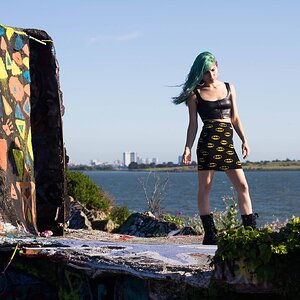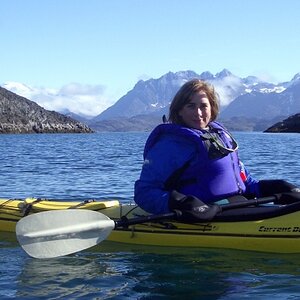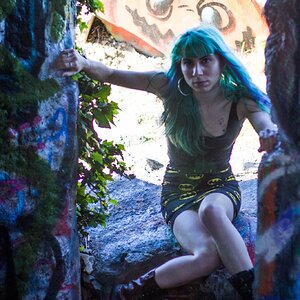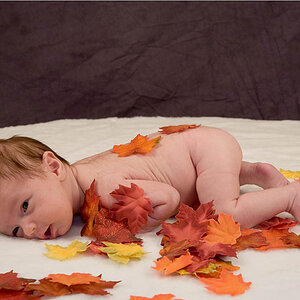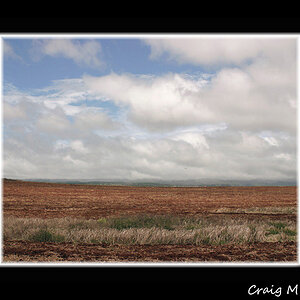Navigation
Install the app
How to install the app on iOS
Follow along with the video below to see how to install our site as a web app on your home screen.

Note: This feature currently requires accessing the site using the built-in Safari browser.
More options
You are using an out of date browser. It may not display this or other websites correctly.
You should upgrade or use an alternative browser.
You should upgrade or use an alternative browser.
how can i correctly expose subject and overexpose background?
- Thread starter junqi
- Start date
pgriz
Been spending a lot of time on here!
- Joined
- Jul 30, 2010
- Messages
- 6,734
- Reaction score
- 3,221
- Location
- Canada
- Can others edit my Photos
- Photos OK to edit
Charlie's right, but there's more to it. If both the background and your subject are lit by the same light source, then over-exposing the background will also overexpose the subject. So the subject has to be in a darker area (or at least in shadow), and then using Charlie's suggestion, you should be able to get the right exposure for your subject while the background becomes over-exposed. The relative difference of light between where your subject is, and the background, will determine how much overexposure you will achieve. For instance, on a bright, sunny day, putting someone in shadow which is lit only by the open sky (but away from the sun), the subject's exposure will typically be about 4 stops more than if you were in the sunlight. That difference narrows to almost none if we're talking an overcast day with no shadows.
petrochemist
TPF junkie!
- Joined
- Mar 9, 2014
- Messages
- 1,873
- Reaction score
- 608
- Can others edit my Photos
- Photos OK to edit
Depending on your subject you may have to either add light to the background or shade the subject. This is the oposite of the usual need for fill in flash I'm sure it's also possible to select the background in photoshop (or similar) and increase the brightness of just that portion of the image, but I always perfer to get it right in camera.
junqi
TPF Noob!
- Joined
- Dec 18, 2014
- Messages
- 67
- Reaction score
- 0
- Can others edit my Photos
- Photos NOT OK to edit
Charlie's right, but there's more to it. If both the background and your subject are lit by the same light source, then over-exposing the background will also overexpose the subject. So the subject has to be in a darker area (or at least in shadow), and then using Charlie's suggestion, you should be able to get the right exposure for your subject while the background becomes over-exposed. The relative difference of light between where your subject is, and the background, will determine how much overexposure you will achieve. For instance, on a bright, sunny day, putting someone in shadow which is lit only by the open sky (but away from the sun), the subject's exposure will typically be about 4 stops more than if you were in the sunlight. That difference narrows to almost none if we're talking an overcast day with no shadows.
Let say the background light is behind the subject and my subject is under a building. If i focus on my subject and overexpose by +1 stop doesn't mean my subject and background will be overexpose as well ? correct me if i am wrong.
junqi
TPF Noob!
- Joined
- Dec 18, 2014
- Messages
- 67
- Reaction score
- 0
- Can others edit my Photos
- Photos NOT OK to edit
Don't confuse metering with focusing. If your camera has the ability to spot meter, then meter your subject.
are you able to phrase in a simple term? how can i meter my subject in order to make my subject correctly expose and background overexpose?
pgriz
Been spending a lot of time on here!
- Joined
- Jul 30, 2010
- Messages
- 6,734
- Reaction score
- 3,221
- Location
- Canada
- Can others edit my Photos
- Photos OK to edit
Charlie's right, but there's more to it. If both the background and your subject are lit by the same light source, then over-exposing the background will also overexpose the subject. So the subject has to be in a darker area (or at least in shadow), and then using Charlie's suggestion, you should be able to get the right exposure for your subject while the background becomes over-exposed. The relative difference of light between where your subject is, and the background, will determine how much overexposure you will achieve. For instance, on a bright, sunny day, putting someone in shadow which is lit only by the open sky (but away from the sun), the subject's exposure will typically be about 4 stops more than if you were in the sunlight. That difference narrows to almost none if we're talking an overcast day with no shadows.
Let say the background light is behind the subject and my subject is under a building. If i focus on my subject and overexpose by +1 stop doesn't mean my subject and background will be overexpose as well ? correct me if i am wrong.
Use your camera's meter to tell you what light levels you're dealing with. In this case, the best metering mode is "spot" meter as Charlie has already suggested. Put your subject in the same light as the background, and take a spot-meter reading of their face (assuming that's what you want to photograph). Let's say you get a reading of 1/500 sec at f/8 at iso 100. Then move your subject into the shadow area and take another reading of their face. You might get something like 1/60 sec at f/8 at iso 100. That's three stops difference. Usually, a 3-stop difference with overexpose the background to almost white (but that depends also on the dynamic range of your camera). So in this scenario, the face (in shadow) will be properly exposed, and the background will be overexposed by 3 stops.
In your last question, you asked about over-exposing by 1 stop. IF both your subject and background are in the same light intensity, then yes, you will overexpose both the background AND your subject. However, if you ensure that your subject is in a darker location compared to the background, then the method I just described will give you the right reading for your subject.
Don't confuse metering with focusing. If your camera has the ability to spot meter, then meter your subject.
If your camera does NOT have the ability to spotmeter, you can still do the light readings by taking a reading off the palm of your hand, first in the light illuminating the background, and then repeat exactly the same reading in the light illuminating your subject. The difference in exposure will tell you what adjustments you need to make.
junqi
TPF Noob!
- Joined
- Dec 18, 2014
- Messages
- 67
- Reaction score
- 0
- Can others edit my Photos
- Photos NOT OK to edit
Charlie's right, but there's more to it. If both the background and your subject are lit by the same light source, then over-exposing the background will also overexpose the subject. So the subject has to be in a darker area (or at least in shadow), and then using Charlie's suggestion, you should be able to get the right exposure for your subject while the background becomes over-exposed. The relative difference of light between where your subject is, and the background, will determine how much overexposure you will achieve. For instance, on a bright, sunny day, putting someone in shadow which is lit only by the open sky (but away from the sun), the subject's exposure will typically be about 4 stops more than if you were in the sunlight. That difference narrows to almost none if we're talking an overcast day with no shadows.
Let say the background light is behind the subject and my subject is under a building. If i focus on my subject and overexpose by +1 stop doesn't mean my subject and background will be overexpose as well ? correct me if i am wrong.
Use your camera's meter to tell you what light levels you're dealing with. In this case, the best metering mode is "spot" meter as Charlie has already suggested. Put your subject in the same light as the background, and take a spot-meter reading of their face (assuming that's what you want to photograph). Let's say you get a reading of 1/500 sec at f/8 at iso 100. Then move your subject into the shadow area and take another reading of their face. You might get something like 1/60 sec at f/8 at iso 100. That's three stops difference. Usually, a 3-stop difference with overexpose the background to almost white (but that depends also on the dynamic range of your camera). So in this scenario, the face (in shadow) will be properly exposed, and the background will be overexposed by 3 stops.
In your last question, you asked about over-exposing by 1 stop. IF both your subject and background are in the same light intensity, then yes, you will overexpose both the background AND your subject. However, if you ensure that your subject is in a darker location compared to the background, then the method I just described will give you the right reading for your subject.
Don't confuse metering with focusing. If your camera has the ability to spot meter, then meter your subject.
If your camera does NOT have the ability to spotmeter, you can still do the light readings by taking a reading off the palm of your hand, first in the light illuminating the background, and then repeat exactly the same reading in the light illuminating your subject. The difference in exposure will tell you what adjustments you need to make.
correct me if i understand wrongly. aren't spot metering only measure middle of the subject? what if the face that i want expose correctly is nearly at the top left of the af point ? let say i put my subject in the same light as the background and take spot meter reading of their face. From the reading you mention i get a reading of 1/500 sec at f8 at iso 100 which is correctly expose?. then i move my subject into the shadow area and take another reading of their face. I then get 1/60sec at f/8 at iso 100 for correctly expose the subject am i right ?
fjrabon
Been spending a lot of time on here!
- Joined
- Nov 3, 2011
- Messages
- 3,644
- Reaction score
- 754
- Location
- Atlanta, GA, USA
- Can others edit my Photos
- Photos OK to edit
The fundamental need for getting this shot, as the others have said, is that you have to have different amounts of light on your background and your subject (unless you want to create a not great looking shot, with lots of effort, in photoshop).
I think it may be beneficial to also discuss what a stop is, and some examples of stops in real life.
A stop in photography terms means light that is twice as bright. 2 stops would be 4 times as bright, because it's twice as bright times 2. 3 stops is 8 times as bright (2x2x2).
An example you come across in the real world is that generally heavy shadow (a complete blockage of direct sunlight) is around 3 stops darker than direct sunlight (ie open sunlight is 8 times as bright). 3 stops is a pretty large difference, so if your subject is in hard shadow and your background is in direct sunlight, then you properly expose for your subject, your background will be 3 stops brighter, which will almost certainly mean it's pretty severely overexposed.
Another example is shooting directly into the sun around sunset. If you position your subject such that the sun is behind them, but expose for your subject, the same effect will be achieved, without needing to place them in shade. This is achieved because the subject's body is providing the shade for itself, and the backlighting is blowing the background out (a term photographers use for extreme overexposure). This look is the current en vogue look for a lot of engagement session photographers (and I suspect why you are asking this question in the first place).
When trying these sorts of shots, I generally advise taking many different exposures (what photographers call bracketing) because they often confuse the camera's built in meter. So start by taking a shot with the exposure you think is correct using ISO 400 in manual mode and then take the same shot at ISO 100, 200, 800 and 1600. With experience you won't typically need to take that many different exposures, but starting off you may. I can usually look at a scene and know within a stop or less what the right exposure would be, but when I was first starting out, bracketing on these sorts of shots saved my life many times.
I think it may be beneficial to also discuss what a stop is, and some examples of stops in real life.
A stop in photography terms means light that is twice as bright. 2 stops would be 4 times as bright, because it's twice as bright times 2. 3 stops is 8 times as bright (2x2x2).
An example you come across in the real world is that generally heavy shadow (a complete blockage of direct sunlight) is around 3 stops darker than direct sunlight (ie open sunlight is 8 times as bright). 3 stops is a pretty large difference, so if your subject is in hard shadow and your background is in direct sunlight, then you properly expose for your subject, your background will be 3 stops brighter, which will almost certainly mean it's pretty severely overexposed.
Another example is shooting directly into the sun around sunset. If you position your subject such that the sun is behind them, but expose for your subject, the same effect will be achieved, without needing to place them in shade. This is achieved because the subject's body is providing the shade for itself, and the backlighting is blowing the background out (a term photographers use for extreme overexposure). This look is the current en vogue look for a lot of engagement session photographers (and I suspect why you are asking this question in the first place).
When trying these sorts of shots, I generally advise taking many different exposures (what photographers call bracketing) because they often confuse the camera's built in meter. So start by taking a shot with the exposure you think is correct using ISO 400 in manual mode and then take the same shot at ISO 100, 200, 800 and 1600. With experience you won't typically need to take that many different exposures, but starting off you may. I can usually look at a scene and know within a stop or less what the right exposure would be, but when I was first starting out, bracketing on these sorts of shots saved my life many times.
fjrabon
Been spending a lot of time on here!
- Joined
- Nov 3, 2011
- Messages
- 3,644
- Reaction score
- 754
- Location
- Atlanta, GA, USA
- Can others edit my Photos
- Photos OK to edit
Shoot in manual mode, meter the person's face, set your exposure for that, then compose however how you would like. You can also use exposure lock in a situation like this. Or you can use exposure compensation.Charlie's right, but there's more to it. If both the background and your subject are lit by the same light source, then over-exposing the background will also overexpose the subject. So the subject has to be in a darker area (or at least in shadow), and then using Charlie's suggestion, you should be able to get the right exposure for your subject while the background becomes over-exposed. The relative difference of light between where your subject is, and the background, will determine how much overexposure you will achieve. For instance, on a bright, sunny day, putting someone in shadow which is lit only by the open sky (but away from the sun), the subject's exposure will typically be about 4 stops more than if you were in the sunlight. That difference narrows to almost none if we're talking an overcast day with no shadows.
Let say the background light is behind the subject and my subject is under a building. If i focus on my subject and overexpose by +1 stop doesn't mean my subject and background will be overexpose as well ? correct me if i am wrong.
Use your camera's meter to tell you what light levels you're dealing with. In this case, the best metering mode is "spot" meter as Charlie has already suggested. Put your subject in the same light as the background, and take a spot-meter reading of their face (assuming that's what you want to photograph). Let's say you get a reading of 1/500 sec at f/8 at iso 100. Then move your subject into the shadow area and take another reading of their face. You might get something like 1/60 sec at f/8 at iso 100. That's three stops difference. Usually, a 3-stop difference with overexpose the background to almost white (but that depends also on the dynamic range of your camera). So in this scenario, the face (in shadow) will be properly exposed, and the background will be overexposed by 3 stops.
In your last question, you asked about over-exposing by 1 stop. IF both your subject and background are in the same light intensity, then yes, you will overexpose both the background AND your subject. However, if you ensure that your subject is in a darker location compared to the background, then the method I just described will give you the right reading for your subject.
Don't confuse metering with focusing. If your camera has the ability to spot meter, then meter your subject.
If your camera does NOT have the ability to spotmeter, you can still do the light readings by taking a reading off the palm of your hand, first in the light illuminating the background, and then repeat exactly the same reading in the light illuminating your subject. The difference in exposure will tell you what adjustments you need to make.
correct me if i understand wrongly. aren't spot metering only measure middle of the subject? what if the face that i want expose correctly is nearly at the top left of the af point ? let say i put my subject in the same light as the background and take spot meter reading of their face. From the reading you mention i get a reading of 1/500 sec at f8 at iso 100 which is correctly expose?. then i move my subject into the shadow area and take another reading of their face. I then get 1/60sec at f/8 at iso 100 for correctly expose the subject am i right ?
pgriz
Been spending a lot of time on here!
- Joined
- Jul 30, 2010
- Messages
- 6,734
- Reaction score
- 3,221
- Location
- Canada
- Can others edit my Photos
- Photos OK to edit
correct me if i understand wrongly. aren't spot metering only measure middle of the subject? what if the face that i want expose correctly is nearly at the top left of the af point ? let say i put my subject in the same light as the background and take spot meter reading of their face. From the reading you mention i get a reading of 1/500 sec at f8 at iso 100 which is correctly expose?. then i move my subject into the shadow area and take another reading of their face. I then get 1/60sec at f/8 at iso 100 for correctly expose the subject am i right ?
How the spot-meter function is implemented depends on the camera. On most, the spot-meter function is on the exact center of the viewfinder, and there is a circle of anywhere from 1-5 degrees in the center, from which the camera takes its reading. On some cameras, the spot-meter follows the active AF point. However, assuming that your camera has its spot-meter function limited to the center part of the viewfinder, you would center the subject in your viewfinder and then take a reading. @fjrabon is adding an important point - you need to take these readings in manual mode, and adjust your exposure until your meter needle is centered.
One of the benefits of doing exposure manually, is that you can replace the very tiny brain your camera has, by the much larger brain you have. So, assuming you have taken the various light readings, and you have a good idea of which exposure you need to use to properly expose your subject in the shade, you set this exposure MANUALLY. You will then reframe the subject so that they satisfy the composition you wish to achieve, but you will have LOCKED the exposure to the correct value. There are also other ways to achieve the same result, again as @fjrabon has noted, by using the features of exposure lock, or exposure compensation.
Keep in mind that auto-focusing (which uses whichever AF point you selected) and exposure calculation (which is determined by the metering mode) are different things. In some advanced cameras, the spot-meter mode CAN be attached to a moving AF point, and you can indicate to the camera which AF point you want to use as the "primary" one. However, if your camera does not have that capability, then the methods described by both fjrabon and myself will work.
soufiej
No longer a newbie, moving up!
- Joined
- Jan 3, 2015
- Messages
- 714
- Reaction score
- 113
- Can others edit my Photos
- Photos NOT OK to edit
Dear all, i having hard time to correctly expose my subject and overexpose background. anyone can guide me how can i overexpose background but subject correct expose?
While you seem to be struggling with the concept of metering vs focusing, the term you used in your op was "correctly".
I would first suggest you sit down with your camera and it's owner's manual. Look over the pages on adjusting where and how your camera meters the lighting of the scene. If you are shooting in any of the fully automatic modes (rather than the "creative" modes [P/AV/TV/M]), you won't have much selection in how the camera sets itself up for a shot. Therefore, I would say the first thing you'll need to do is learn how to shoot in something other than a fully automatic mode. Do you understand how these modes operate and how to change settings within them to achieve a "creative" result? If so, then changing your camera to spot meter a scene should become second nature after a few tries. Just look up "spot metering" in your camera's owner's manual. That will tell you exactly how to begin the process.
Next, assume there is no such thing as "correct" exposure when dealing with a digital camera. First, exposure is "correct" for a scene as viewed by a specific person. You and I may have different ideas about what a correct exposure would be and neither of us would necessarily be wrong. Within reason, exposure is subjective and not right or wrong. Certainly, if you are shooting in fully automatic modes, your camera knows this fact.
Second, unless you are dealing with an image directly out of your camera - a Jpeg format image - you will need to do a bit of processing to achieve your desired results. Even spot metering of a subject standing in a shaded area with a bright sky in the background won't necessarily give you the "correct" exposure for either. "Correct" being an undefined term that resides in your mind only. There will always be a fair amount of latitude between what you get from your camera and what you consider "correct" exposure of both elements of the image under such conditions. Your eyes can perceive far more dynamic range - the difference between the lightest and the darkest area of an image - than your camera can capture in a single image. You may see "correct" exposure now as a value which your camera may not have the ability to capture in a single image. If that's the case, we have now entered a totally different discussion.
I would say the best thing to do is to achieve your result in post processing. Most of the more sophisticated processing software will allow you to mask off one area while working on another. This can be done with either a Jpeg straight from the camera or in any form of data you present to the processor. Does your camera have the ability to shoot and store images in RAW format? If so, there is more latitude in RAW to adjust the image to your liking. Jpeg's, the preferred process for most compact cameras, has less adjustment potential but can still be altered in post processing.
Now, you've got yourself into a technique in photography where you are asking about some slightly more advanced techniques. Either metering with your camera and hoping for the "correct" result or using more sophisticated software to process your image to the correct levels you see in your head is going to require some more sophisticated thinking on your part. I'm not a great fan of extensive processing but even I would select the latter as the more appropriate choice for your needs. You have far more control over your image in post processing than you can achieve in the camera once you intend to fool the camera into working against its best interests. By processing the image at your computer you can adjust exposure of specific areas to achieve just what you envision as "correct". Not all software though will be capable of such adjustments. You may need to learn new processing software to get where you want to go.
What camera do you own? Do you shoot and process in Jpeg or RAW? Which processing software do you use? How good are you at processing an image?
Last edited:
fjrabon
Been spending a lot of time on here!
- Joined
- Nov 3, 2011
- Messages
- 3,644
- Reaction score
- 754
- Location
- Atlanta, GA, USA
- Can others edit my Photos
- Photos OK to edit
right, I generally think that cameras' built in meters are pretty good these days, but these sorts of shots, with a subject much darker than the background, tend to confuse cameras the most (one only needs to look at most travel pictures posted to facebook, where the person is drastically underexposed and the background is perfectly exposed to see this in action). In most situations the subject is brighter than the background, and the camera generally has a bias to never overexpose, so when you have a darker subject and a brighter background, you generally are going to need manual mode (or exposure compensation, but in this situation I generally find using exposure compensation actually just complicates matters, as you're having to guess how off the camera is, which can be tricky to know just how bad it's likely to mess up).correct me if i understand wrongly. aren't spot metering only measure middle of the subject? what if the face that i want expose correctly is nearly at the top left of the af point ? let say i put my subject in the same light as the background and take spot meter reading of their face. From the reading you mention i get a reading of 1/500 sec at f8 at iso 100 which is correctly expose?. then i move my subject into the shadow area and take another reading of their face. I then get 1/60sec at f/8 at iso 100 for correctly expose the subject am i right ?
How the spot-meter function is implemented depends on the camera. On most, the spot-meter function is on the exact center of the viewfinder, and there is a circle of anywhere from 1-5 degrees in the center, from which the camera takes its reading. On some cameras, the spot-meter follows the active AF point. However, assuming that your camera has its spot-meter function limited to the center part of the viewfinder, you would center the subject in your viewfinder and then take a reading. @fjrabon is adding an important point - you need to take these readings in manual mode, and adjust your exposure until your meter needle is centered.
One of the benefits of doing exposure manually, is that you can replace the very tiny brain your camera has, by the much larger brain you have. So, assuming you have taken the various light readings, and you have a good idea of which exposure you need to use to properly expose your subject in the shade, you set this exposure MANUALLY. You will then reframe the subject so that they satisfy the composition you wish to achieve, but you will have LOCKED the exposure to the correct value. There are also other ways to achieve the same result, again as @fjrabon has noted, by using the features of exposure lock, or exposure compensation.
Keep in mind that auto-focusing (which uses whichever AF point you selected) and exposure calculation (which is determined by the metering mode) are different things. In some advanced cameras, the spot-meter mode CAN be attached to a moving AF point, and you can indicate to the camera which AF point you want to use as the "primary" one. However, if your camera does not have that capability, then the methods described by both fjrabon and myself will work.
junqi
TPF Noob!
- Joined
- Dec 18, 2014
- Messages
- 67
- Reaction score
- 0
- Can others edit my Photos
- Photos NOT OK to edit
correct me if i understand wrongly. aren't spot metering only measure middle of the subject? what if the face that i want expose correctly is nearly at the top left of the af point ? let say i put my subject in the same light as the background and take spot meter reading of their face. From the reading you mention i get a reading of 1/500 sec at f8 at iso 100 which is correctly expose?. then i move my subject into the shadow area and take another reading of their face. I then get 1/60sec at f/8 at iso 100 for correctly expose the subject am i right ?
How the spot-meter function is implemented depends on the camera. On most, the spot-meter function is on the exact center of the viewfinder, and there is a circle of anywhere from 1-5 degrees in the center, from which the camera takes its reading. On some cameras, the spot-meter follows the active AF point. However, assuming that your camera has its spot-meter function limited to the center part of the viewfinder, you would center the subject in your viewfinder and then take a reading. @fjrabon is adding an important point - you need to take these readings in manual mode, and adjust your exposure until your meter needle is centered.
One of the benefits of doing exposure manually, is that you can replace the very tiny brain your camera has, by the much larger brain you have. So, assuming you have taken the various light readings, and you have a good idea of which exposure you need to use to properly expose your subject in the shade, you set this exposure MANUALLY. You will then reframe the subject so that they satisfy the composition you wish to achieve, but you will have LOCKED the exposure to the correct value. There are also other ways to achieve the same result, again as @fjrabon has noted, by using the features of exposure lock, or exposure compensation.
Keep in mind that auto-focusing (which uses whichever AF point you selected) and exposure calculation (which is determined by the metering mode) are different things. In some advanced cameras, the spot-meter mode CAN be attached to a moving AF point, and you can indicate to the camera which AF point you want to use as the "primary" one. However, if your camera does not have that capability, then the methods described by both fjrabon and myself will work.
i just bring out my camera to play it out. correct me if i'm wrong i use spot meter to correct the exposure the subject my subject is a water bottle which the light meter indicate at center with spot meter using at f2.8 1/200 iso 100 i recompose it so that i can see the background as well. now the setting will be f2.8 1/60 iso 100 this will overexpose the background. am i doing the correct way ?
Similar threads
- Replies
- 6
- Views
- 146
- Replies
- 12
- Views
- 143
- Replies
- 6
- Views
- 2K
- Replies
- 2
- Views
- 1K

![[No title]](/data/xfmg/thumbnail/37/37602-1ef8dbb1c2d0e4ff347ee65d328c3603.jpg?1619738147)
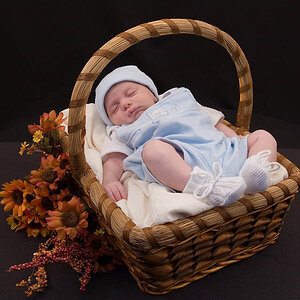
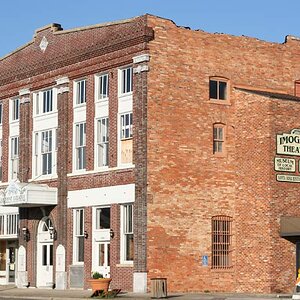

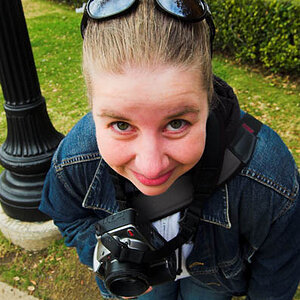
![[No title]](/data/xfmg/thumbnail/1/1592-cfae4a7ea791f96c6e2d03484be2e454.jpg?1619729144)
![[No title]](/data/xfmg/thumbnail/37/37605-90c8efaef5b7d1f52d4bf8e7dfd33673.jpg?1619738148)
